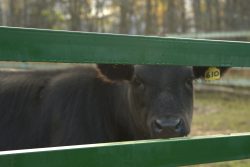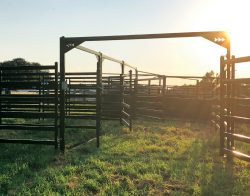New to Ranching? Here’s the Perfect Cattle Handling System for You.
By Kaydence Michalsky
Starting up a cattle operation, no matter how small, can be intimidating. Every day brings its own challenges, whether it’s dealing with unpredictable weather, ever-changing market prices, or finding cattle equipment that gives you confidence and peace of mind when working cattle.
For decades, cattle equipment companies have tailored their equipment to ranchers who run hundreds of head of cattle. This leaves operations with small herds of 10 to 20 head trying to make-do with equipment meant for much bigger operations, which can lead to unnecessary expenses and valuable space being taken up. Using a system that is too large for the needs of your operation leaves more room for error and injury. However, with a cattle handling system designed specifically for 10 to 20 head of cattle, new or small-scale ranchers can streamline their operation and ensure safety throughout.
Often, the livestock industry focuses on serving the needs of large-scale cattle ranches, which can leave newcomers and small operations feeling left behind and frustrated. It needs to be remembered that small-scale ranches face different challenges such as less access to resources and manpower to help manage livestock efficiently. Handling even a small amount of cattle can be dangerous, especially if you have limited help, so it’s key to ensure you have proper cattle equipment.
This is where Arrowquip’s 10 and 20 Head Starter Cattle Handling Systems come in. These systems are specifically designed to help solve some of the challenges small-scale ranchers face on a day-to-day basis at an attainable price. By offering affordable, easy-to-use, and safe solutions, small-scale and new ranchers can handle their cattle with confidence.
Advanced Efficiency No Matter the Size of Your Cattle Operation
For ranchers who are working to build up their herd and have less than 20 head of cattle, these small starter systems are the perfect addition. These systems have been designed by Arrowquip’s cattle handling experts using the same equipment that many have come to love, including Arrow Corral Panels, gates, and the all-new Arrowlock cattle chutes, to increase efficiency on your ranch and make cattle handling easier than ever. Within both the 10 and 20-Head Starter System families, there are three designs to help cater to the unique needs of every operation: Basic, Essential, and Deluxe.
The Basic designs feature corral panels and gates that are placed in a way that works with cattle’s natural instincts to move along curves. Cattle will follow the curve into a panel force that will then guide them into the Arrowlock 55 Series Squeeze Chute, making the process of handling cattle faster and easier than before.
A step up from the Basic design is the Essential Starter System. This system features everything in the Basic design with the addition of an alley made using cattle corral panels and a rolling alley gate that can be used from either side to encourage better flow into the chute.
For ranchers looking for a more advanced cattle handling experience, the 10 and 20 Head Deluxe Cattle Handling Systems are the perfect solution. The Deluxe system is equipped with more corral panels for more space and the panel alley is replaced with an 8’ Easy Flow Adjustable Cattle Alley for more efficient movement into the chute. Additionally, the cattle chute in these systems has been upgraded to the Arrowlock 75 Series which is equipped with a vet cage that allows the operator more access to the animal while in the chute. 
Tailored Cattle Handling Systems for Your Herd Size
If you’re just starting out and can count the amount of cattle you have on less than two hands, then the 10-Head Basic Starter Cattle Handling System will be the perfect fit for you. However, don’t let the size of the system stop you from expanding your herd.
As a leader in cattle equipment, Arrowquip wants to ensure that you can have a system that will work for you 100% of the time. This is why all their systems are completely customizable and all components can be added or removed with ease. Want to increase efficiency and upgrade your cattle chute from manual to hydraulic? No problem! Need a bigger system? Easily add as many corral panels as you need using the panel connectors.
It’s important to ensure you have equipment that allows you to work and handle your cattle safely and efficiently no matter the size of your herd. By offering affordable, easy-to-use, and safe solutions, small-scale and new producers will be able to handle their cattle with confidence. For more information, or to get in touch with a Livestock Expert, visit www.arrowquip.com.



